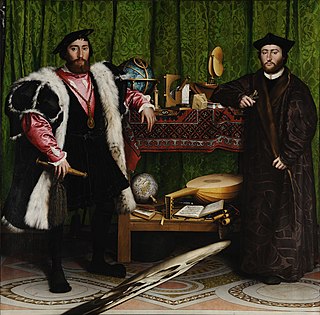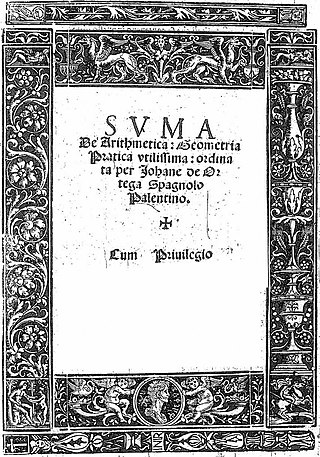Related Research Articles

Johann Carl Friedrich Gauss was a German mathematician and physicist who made significant contributions to many fields in mathematics and science. Sometimes referred to as the Princeps mathematicorum and "the greatest mathematician since antiquity", Gauss had an exceptional influence in many fields of mathematics and science, and he is ranked among history's most influential mathematicians.

The Danse Macabre, also called the Dance of Death, is an artistic genre of allegory of the Late Middle Ages on the universality of death.

Enrico Bombieri is an Italian mathematician, known for his work in analytic number theory, Diophantine geometry, complex analysis, and group theory. Bombieri is currently Professor Emeritus in the School of Mathematics at the Institute for Advanced Study in Princeton, New Jersey. Bombieri won the Fields Medal in 1974 for his contributions to large sieve mathematics, conceptualized by Linnick 1941, and its application to the distribution of prime numbers.

Hans Holbein the Younger was a German-Swiss painter and printmaker who worked in a Northern Renaissance style, and is considered one of the greatest portraitists of the 16th century. He also produced religious art, satire, and Reformation propaganda, and he made a significant contribution to the history of book design. He is called "the Younger" to distinguish him from his father Hans Holbein the Elder, an accomplished painter of the Late Gothic school.

Friedrich Ludwig Gottlob Frege was a German philosopher, logician, and mathematician. He was a mathematics professor at the University of Jena, and is understood by many to be the father of analytic philosophy, concentrating on the philosophy of language, logic, and mathematics. Though he was largely ignored during his lifetime, Giuseppe Peano (1858–1932), Bertrand Russell (1872–1970), and, to some extent, Ludwig Wittgenstein (1889–1951) introduced his work to later generations of philosophers. Frege is widely considered to be the greatest logician since Aristotle, and one of the most profound philosophers of mathematics ever.
This article contains information about the literary events and publications of 1617.

Leonard Nelson, sometimes spelt Leonhard, was a German mathematician, critical philosopher, and socialist. He was part of the neo-Friesian school of neo-Kantianism and a friend of the mathematician David Hilbert. He devised the Grelling–Nelson paradox in 1908 and the related idea of autological words with Kurt Grelling.
The year 1918 in science and technology involved some significant events, listed below.
The year 1841 in science and technology involved some significant events, listed below.
The year 1880 in science and technology included many events, some of which are listed here.
The year 1861 in science and technology involved some significant events, listed below.
The year 1703 in science and technology involved some significant events.
The year 1611 in science and technology involved some significant events.

Petrus Apianus, also known as Peter Apian, Peter Bennewitz, and Peter Bienewitz, was a German humanist, known for his works in mathematics, astronomy and cartography. His work on "cosmography", the field that dealt with the earth and its position in the universe, was presented in his most famous publications, Astronomicum Caesareum (1540) and Cosmographicus liber (1524). His books were extremely influential in his time, with the numerous editions in multiple languages being published until 1609. The lunar crater Apianus and asteroid 19139 Apian are named in his honour.

Johannes Widmann was a German mathematician. The + and - symbols first appeared in print in his book Mercantile Arithmetic or Behende und hüpsche Rechenung auff allen Kauffmanschafft published in Leipzig in 1489 in reference to surpluses and deficits in business problems.

The Ambassadors is a 1533 painting by Hans Holbein the Younger. Also known as Jean de Dinteville and Georges de Selve, after the two people it portrays, it was created in the Tudor period, in the same year Elizabeth I was born. Franny Moyle speculates that Elizabeth's mother, Anne Boleyn, then Queen of England, might have commissioned the painting as a gift for Jean de Dinteville, the ambassador portrayed on the left in the painting. As well as being a double portrait, the painting contains a still life of several meticulously rendered objects, the meaning of which is the cause of much debate. It also incorporates one of the best-known examples of anamorphosis in painting. The Ambassadors has been part of London's National Gallery collection since its purchase in 1890.
The year 1500 AD in science and technology included many events, some of which are listed here.
The year 1541 in science and technology included a number of events, some of which are listed here.
Events from the year 1717 in France

Juan de Ortega, was a Spanish mathematician. He wrote some of the earliest works on commercial arithmetic, and discovered an improved method for calculating square roots.
References
- ↑ Depicted in Holbein's painting The Ambassadors (1533) – "Arithmetic Book". Holbein's The Ambassadors and Renaissance Ideas of Knowledge. SUNY. Archived from the original on 23 July 2011. Retrieved 2011-08-08.